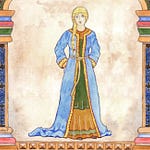Ælfgif-who? provides short biographies of early medieval English women. Click on the podcast player if you’d like to hear this newsletter read aloud in my appealing Yorkshire accent.

The first ever Ælfgif-who? newsletter was about one of my favourite lesser-known medieval queens: Cynethryth, who was the queen of the kingdom of Mercia and flourished in the period 770-98. Today’s Ælfgif-who? newsletter revisits Cynethryth’s story, after an exciting new discovery has changed the way we think about her and one of her contemporaries - Fastrada, the wife of Charlemagne.
Cynethryth was the wife of King Offa, and is a compelling figure, not least because we have dozens of surviving coins that contain her name and portrait. There are over fifty surviving coins from the mid-780s depicting Queen Cynethryth’s name and image. One side shows her face, while the other side reads ‘CYNETHRYTH REGIN[A] M[ERCIORUM]’, a Latin inscription meaning ‘Queen Cynethryth of Mercia’.
Cynethryth’s coins are important because they are unique - she is the earliest medieval queen to have her own coinage, and the only early medieval woman in western Europe to have her portrait on coins. These coins also contain the earliest portrait of any English queen.
I thought Cynethryth was the perfect figure to kick off the first edition of Ælfgif-who? back in March 2021. Powerful and influential in her lifetime, she left a uniquely important record of evidence for historians, and yet she has been all but forgotten, even among history enthusiasts:
Now, a new discovery has been made that sheds new light on the significance of Cynethryth and her coinage. Recently, the Centre Charlemagne, in Aachen, acquired a previously unknown type of Carolingian coin: one containing the name of Charlemagne’s third wife, Fastrada.

There are a number of interesting parallels between Cynethryth and Fastrada. They were both active in roughly the same period, though on different sides of the Channel. It has been well established by historians that their husbands, Offa and Charlemagne, had a close political relationship throughout their reigns.
Fastrada’s coin, dating to about a decade after Cynethryth’s coinage, is different in that it does not contain a portrait, only a name - but it does include the same title as Cynethryth’s, written in the same way - ‘REGIN[A]’, with the ‘A’ abbreviated. Numismatist (coin expert) Simon Coupland has argued very convincingly that Fastrada’s coin was directly inspired by Cynethryth’s. Not only does this underline Cynethryth’s importance, but it demonstrates that the direction of influence between Offa and Charlemagne in this period was not only travelling from Francia to Mercia, but vice-versa.
Historian Jinty Nelson has described Fastrada as having a ‘uniquely well-documented queenly career’, and as ‘politically important in her own right’, but she has also noted that many historical studies of Charlemagne simply leave her out.1 Prof Nelson has made much of the fact that Charlemagne clearly loved his wife Fastrada, addressing her as ‘our dear and very lovely wife the queen’ in a letter.
The discovery of Fastrada’s coinage further suggests that, like Cynethryth, she was able to share influence with her powerful husband. Most importantly, we can still view Cynethryth as a trailblazer, but this coin demonstrates that she was not simply an anomaly.
Dr Coupland’s article explaining why the discovery of this coin is groundbreaking has been published open-access, meaning that anyone can read it without a subscription or an academic affiliation. I strongly suggest taking advantage of this, not least for the fascinating discussion about the amount of forgeries and counterfeits of Carolingian coins that end up on eBay!
It is my hope that the attention devoted to the exciting recent discovery of this coin can further help to bring these two remarkable eighth-century queens, Cynethryth and Fastrada, out of obscurity and into the public eye.
Jinty Nelson, Charlemagne: King and Emperor (Penguin Books, 2020).














Share this post